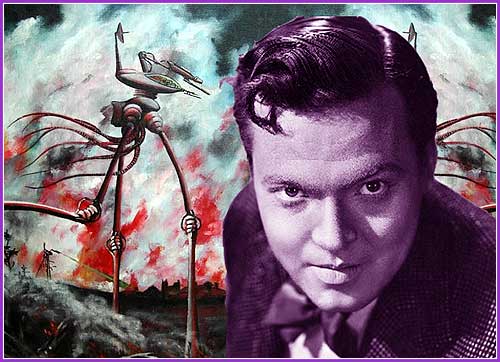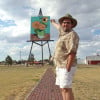The Power Of Panic: Orson Welles and "The War Of The Worlds"

For many, memories of Halloween involve elaborate costumes, trick-or-treating, a party with family or a scary movie with friends. For me, those memories involve leaving the trick-or-treating, the party, or forgoing the movie. They mean locking myself into the family car, turning the ignition and scrolling through the AM spectrum, searching for “it.” Knowing that somewhere out there amid the static and noise, a station was playing Orson Welles’ and the Mercury Theatre’s broadcast of “War of the Worlds”. I’d fine tune that knob until it came in, surrounding me with the story of invading Martians advancing on New York with death ray’s blazing. Alone, out underneath the stars on Halloween night, with only Orson’s deep baratone voice keeping me company. And every year, it scared me out of my mind, like so many that were frightened by the original broadcast of 1939. But why? Why did that broadcast cause such a widespread panic from people who believed it to be true? Why have newer, updated versions of the story (despite overwhelming advertising of it being “just a dramatic play”) continued the trend? Why has this story endured? Is it the timelessness of the tale? Or the delivery system? Is radio such a powerful force it can tap into the psyche of someone like myself, born in the 70’s, long after the Golden Age was over? Or is it a more basic human need—to believe the fantastic, no matter how implausible?
War of the Worlds was originally published as a nine part serial in 1887. It was an immediate commercial and critical success, and has been continuously in print for over 100 years. The story has been told in novels, in comic books, in a musical, in movies and television. It’s been the source inspiration for some and a subject of parody for others. But none of these formats compares to the power of Radio and the Panic Broadcast.
Orson Welles, working from a scripted adaptation by Howard Koch, staged the invasion through a series of news broadcasts that interrupted the so-called “regular” programming. The key to the success of the broadcast was that initially, no-one listened. Most of the radio audience was tuned to “the Chase and Sanborn Hour” the top program of the time, on another network when “War Of The Worlds” started. But, when they broke for a musical interlude at 12 minutes past 8pm—in what may be the first mass instance of Channel Surfing—an estimated 12 million listeners switched stations to see what else was on.
What they heard was reporter Carl Phillips arriving at Grovers Mill just in time for the first martians to start crawling out of the smoking pit and being death raying people. That description captivated the audience, and they stuck around to hear Martian war machines advance on and proceed to destroy New York. And people, who relied on Radio to bring them the news, believed it. Estimates run as high as over 1,000,000 people panicked over the invasion, and while that number and severity of what ensued on October 30th, 1939 differ among historians one thing is certain: There was a response, not just in New York, but across the country.
After the fallout from the broadcast, you’d think people would have learned their lesson. But on November 12, 1944, six years after the scare, a radio station in Santiago Chile broadcast their own adaptation of Koch’s script. Updated to include references to the Red Cross and the Minister of the Interior, the show caused widespread panic, and had one Provincial Governor mobilize troops to repel the invaders.
A little over four years later on February 12, 1949, a group in Quito, Ecuador broadcast their own version of an invasion from Mars story, but unlike before, it was decided NOT to tell anyone that it was a play. Thousands were roused from their homes and fled into the streets. By the time the station employees realized what they had done, it was too late. They announced the story was a hoax, and the panicked mob became an angry mob, and tossed lit newspapers soaked with gasoline into the building. The police and military were called out to quell the riot, but they were already on their way to the neighboring town of Cotocallao to attack the Martians. Ultimately the building burned to the ground and final counts list 20 people dead, the first casualties of the war with Mars.
October 31st, 1968. In honor of the thiryth anniversary of the Orson Welles broadcast, station WKBW in Buffalo New York plans to broadcast its own, updated version of "The War Of The Worlds." Despite massive preperation by the station, 28 days of adverstising every hour on the hour, and press releases sent to anyone who MIGHT be affected, over 4000 residents panicked and called authorities to warn them of the martian invasion of Buffalo. You can here their version HERE.
So how is it that long after television rises to become the preferred method for disseminating information that a lone Radio station was still able to unintentionally dupe thousands of people?
Human beings, despite our technological advances, are primitives. We really aren’t all that far removed from our savage ancestors. We’re quick to dismiss things we don’t understand and superstitious of things we can’t. We need there to be order in the chaos—just look at organized religion. Any religion, at its core deals with a concept or story so fantastic any rational man would dismiss it out of hand entirely. And yet, people are so ardent in their beliefs wars have been fought over a matter of faith. We are paranoid creatures, H.G. Wells knew this when he wrote the book, you have only to flip through its pages to see how scathing his opinion was of humanity. And most of all, we are afraid. We are afraid of the thing that man has been afraid of since the invention of fire.
We’re afraid of the dark, and the things that might be in it.
War of the Worlds preys upon that ultimate fear: Space. A place so vast we can’t comprehend its size, a place so alien from our warm fragile orb we can’t wrap our minds around it, a place so dark, it only comes out at night. And now things come out of that fathomless black dark of space, and they have come to our home and they mean us harm.
So which is it? The story; the power of Radio; or the human condition? Which of these is to blame for the panic unleashed that night in 1938 and in all the ones since? Ultimately, I think the reason is some combination of all three. Time after time, despite the fact that it’s “just a play”, War Of The Worlds manages to get inside our heads with its excitement and paranoia. Even I, who know the nuances of this broadcast nearly inside and out, can still close my eyes and be transported to the scene of the alien invasion. And perhaps that’s the true power of Radio:
To wield the mighty paintbrush of imagination within the human mind.
I believe Orson Welles knew this.








